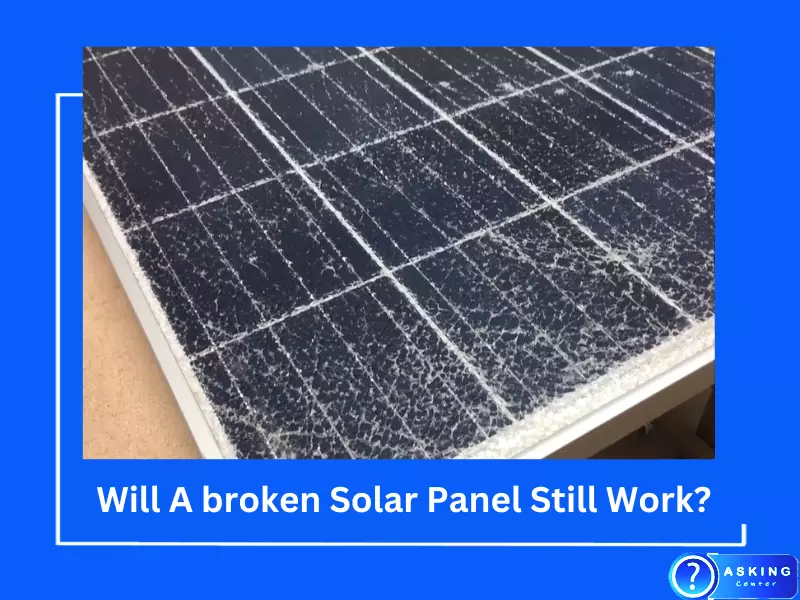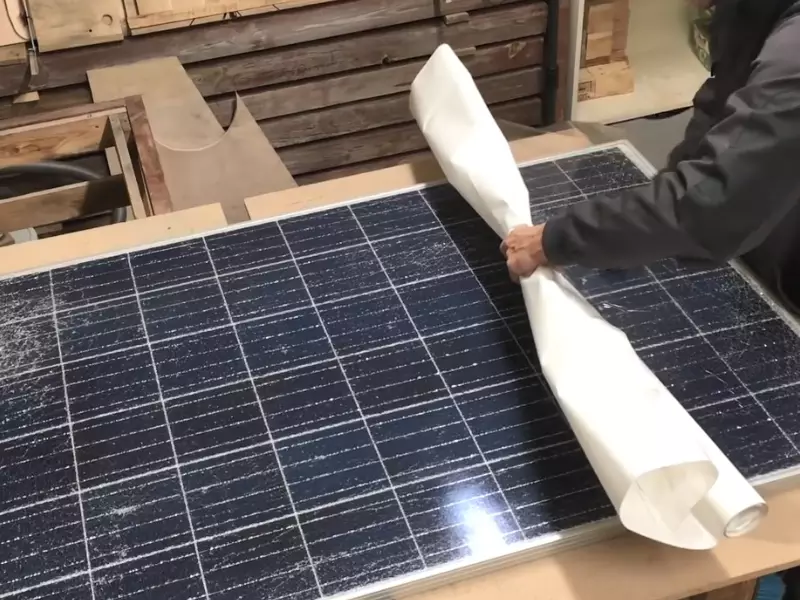Solar energy has become a cornerstone in the quest for clean, renewable energy sources. Solar panels, which convert sunlight into electricity, have seen widespread adoption for both residential and commercial uses. However, like any technological device, solar panels are susceptible to damage and breakage, impacting their functionality and efficiency.
When a solar panel breaks or cracks, it can still produce electricity but to a lesser degree. The efficiency of the panel is compromised due to the disruption of the photovoltaic cells embedded within the panel. Despite this, a broken panel isn’t rendered entirely useless; it can provide power albeit in a reduced capacity.
Recognizing the signs of damage and understanding the implications are crucial for optimal solar panel maintenance. This piece aims to shed light on the performance of a broken solar panel, identify potential dangers, and suggest appropriate remedies, allowing you to make informed decisions and get the most out of your solar investment.
Understanding How Solar Panels Work
Solar panels work on the principle of the photovoltaic effect. Silicon-based photovoltaic cells absorb sunlight, facilitating the flow of electricity. When the sunlight hits the silicon cells, it stimulates the movement of electrons, creating a direct current (DC).
This DC is then converted into alternating current (AC) by an inverter, which can be used to power homes and businesses. Any disruption to this process, such as damage to the cells, impacts the panel’s ability to generate electricity.

What Happens When A Solar Panel Breaks
Common Causes of Solar Panel Breakage
Solar panels are robust and designed to withstand a variety of environmental conditions. However, they can break due to various factors:
- Severe Weather: Storms, hail, heavy snow, and high winds can cause physical damage to solar panels.
- Falling Debris: Branches, rocks, or other debris carried by wind can hit the panels, causing cracks or breakage.
- Aging: Over time, wear and tear can cause panels to crack or break.
- Installation Errors: If not installed correctly, panels may be prone to damage.
Impact on Functionality
When a panel breaks, the photovoltaic cells within it may become exposed or damaged. This disrupts the pathway of the electrons, leading to a reduced power output. The level of impact largely depends on the extent of the damage; a small crack may result in a slight drop in efficiency, while a severe break could render the panel almost useless.
Safety Concerns
Safety can also be a concern when dealing with broken solar panels. The broken glass or sharp edges can pose a physical risk. Additionally, the damaged cells may become susceptible to moisture ingress, leading to potential electrical hazards, like short circuits or electrical shocks.
Will a Cracked Solar Panel Still Work?
Cracked Panels and Power Generation
Despite the damage, cracked solar panels can still produce electricity. However, their efficiency diminishes due to the disrupted electron pathway. If a panel is cracked in such a way that only a portion of the cells is damaged, the remaining undamaged cells will continue to produce electricity, albeit with reduced efficiency.
The Impact of Damage on Performance
The performance of a cracked panel largely depends on the extent and location of the damage. For instance, if the breakage is minimal and located away from the critical photovoltaic cells, the panel may continue to function reasonably well. On the other hand, if the cracks extend across several cells, the panel’s performance can be significantly reduced.
Testing a Panel’s Power Output Using a Voltmeter
A practical way to determine the impact of damage on a panel’s performance is by using a voltmeter. This device measures the power output of the panel, which can provide insights into how the damage has affected its performance. A significantly reduced reading, compared to the panel’s expected output, indicates severe impairment in its functionality.
Using a Cracked Panel: Is it Possible and Wise?
Electricity Production from Cracked Panels
While a cracked solar panel can technically still function and produce electricity, its efficiency is compromised. As a result, the energy yield from such a panel will be less than that from an intact one, which can impact the overall performance of your solar system.
The Risks of Using a Cracked Panel
Using a damaged panel is not without risks. Exposure to the elements can lead to further degradation of the panel. Moisture intrusion, in particular, can lead to electrical shorts or corrosion of the internal components. This not only jeopardizes the panel’s performance but also poses potential safety risks.
Weighing the Pros and Cons
Before deciding to continue using a cracked panel, it’s essential to weigh the potential energy savings against the costs and risks. While it might still produce electricity, the reduced efficiency means you won’t be getting the maximum benefit from your solar system. Additionally, the potential for further damage or safety hazards should not be underestimated.

When Panels Become Nonfunctional
Determining Factors of Non-Functionality
Solar panels may become nonfunctional due to extensive damage. Complete shattering of the glass surface, damage to the photovoltaic cells, or moisture infiltration leading to corrosion or electrical shorts are some scenarios that can render a panel entirely nonfunctional.
Potential Fixes and Mitigation Strategies
If a panel becomes nonfunctional, it’s crucial to have it inspected by a professional. In some cases, if the damage is localized to a specific area, it might be possible to repair the panel or replace the individual cells. However, in most cases of severe damage, replacement of the entire panel is the more viable and safe option.
Identifying Signs of Solar Panel Damage
Visible Signs of Damage
Visible inspection is the first step in identifying solar panel damage. Look for cracks, fractures, or shattering on the glass surface. Also, check for signs of discoloration, which might indicate cell damage or moisture intrusion.
Performance-Related Indicators
If the power output of your solar system is lower than expected, this could be an indicator of panel damage. Monitoring your system’s performance and comparing it to the expected power output can help you identify any issues early on.
What Should You Do When You Find a Cracked or Broken Panel?
Immediate Steps to Take
If you discover that a panel is cracked or broken, it’s important to isolate it from the rest of the system to prevent potential electrical hazards. Avoid touching the panel without appropriate protective equipment, as broken panels can still produce electricity.
When to Contact a Professional
Reach out to a solar panel repair professional as soon as you identify any damage. They can assess the condition of the panel, determine whether it can be repaired or needs to be replaced, and advise you on the best course of action.
DIY vs Professional Repair
While it may be tempting to try to repair the panel yourself, it’s generally advisable to leave this task to professionals. Handling damaged panels can be dangerous, and improper repair can lead to further damage or even risk voiding your panel’s warranty.
Deciding Whether to Replace a Broken Panel
Criteria for Replacement
The decision to replace a broken panel should be based on several factors. The extent of the damage, the cost of repair vs replacement, the panel’s age, and its remaining warranty period are all important considerations.
The Cost-Benefit Analysis of Repair vs. Replacement
If the cost of repairing a damaged panel is close to or exceeds the cost of a new panel, replacement is the more economical option. Additionally, a new panel will likely have a longer lifespan and better efficiency than a repaired one.
When to Replace a Broken Panel
A panel should be replaced if it’s nonfunctional, has extensive damage, is nearing the end of its lifespan, or if the repair costs are prohibitively high.
How to Prevent Solar Panel Damage
Regular Maintenance and Inspection
Regularly inspecting your solar panels can help you spot and address issues early on. Check for visible signs of damage and monitor the system’s performance to ensure it’s in line with expectations.
Protecting Solar Panels from Environmental Factors
While solar panels are designed to be weather-resistant, you can take additional steps to protect them. For example, trim overhanging branches to prevent damage from falling debris, and ensure your panels are installed securely to withstand high winds.

Maximizing Your Panels’ Lifespan
Care and Maintenance Tips
To prolong the lifespan of your solar panels, proper care and maintenance are essential. Here are a few tips:
- Clean Regularly: Accumulation of dust, debris, or bird droppings can hinder sunlight from reaching the photovoltaic cells, reducing the panel’s efficiency. Regular cleaning can prevent this.
- Proper Installation: Ensure the solar panels are installed correctly and securely to minimize damage from environmental factors. Engage professionals for installation to guarantee the job is done right.
- Regular Inspections: Periodic inspections can help detect potential issues early, allowing for timely intervention and preventing further damage.
- Avoid Shade: Shade can reduce the efficiency of solar panels. Where possible, install your panels in an area that receives ample sunlight.
Importance of Regular Inspection
Routine inspection is crucial in maintaining the longevity and efficiency of your solar panels. Through regular checks, you can promptly identify and address issues like cracks, which could otherwise lead to reduced power output or further damage.
Importance of Solar Panel Warranty and Insurance
What Solar Panel Warranties Cover
Solar panel warranties typically cover manufacturing defects and ensure a certain level of efficiency over the warranty period. Should your panels fail or underperform due to manufacturing defects within the warranty period, the manufacturer will repair, replace, or reimburse you for the panels.
How Insurance Can Help in Case of Damage
Having solar panel insurance can provide additional protection beyond the manufacturer’s warranty. This can cover damage from incidents like storms or vandalism that aren’t typically covered by warranties. Insurance can help cover the cost of repair or replacement, ensuring that your solar energy system continues to serve you effectively.
Conclusion
Understanding the implications of solar panel damage is crucial to maximizing the performance and lifespan of your solar system. While a cracked solar panel can still produce electricity, the efficiency is significantly reduced, and it may pose safety risks.
Regular maintenance, inspection, and timely professional intervention can help you get the most out of your solar investment. And while damage is sometimes unavoidable, a comprehensive warranty and insurance can provide you with peace of mind and financial protection.
